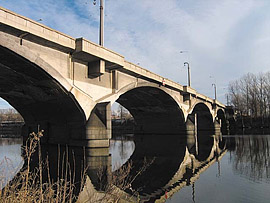
On the Libeň Bridge in Prague, static tests have started
 |
“The tests are meant to tell us what the bridge can withstand and how it behaves. The tests are untypical; they are larger than when two trams meet. We are starting to see possibilities for how to repair the bridge and what method will be best,” said Deputy Prague Mayor Petr Dolínek to journalists.
The bridge should be able to withstand up to 190 tons. The tests aim to ascertain the condition of the bridge and assess the options for its reconstruction. Deformations of the arches and temperatures outside the bridge are being monitored, among other things. After July 16, experts will also perform drilled probes and take concrete samples.
The Prague City Council approved the reconstruction last year, but the start date is not known. The city is awaiting a decision from the Ministry of Culture, which is discussing declaring the bridge a monument. A recent study of the Libeň Bridge revealed that the concrete pillars are damaged by corrosion and the mechanical properties of the concrete are unstable, reported the Klokner Institute of the Czech Technical University, which is conducting the survey.
The bridge, built in 1928, has long been in a state of disrepair. “We are looking very closely at the parts in the subfoundation, which have shown, for example, that the concrete is affected by relatively intense sulfate corrosion. Part of our work also includes testing and preparing remediation methods,” said Jiří Kolísko, director of the Klokner Institute, today.
Since the Libeň Bridge was put into operation in 1928, its load-bearing structure has never been repaired. The authors of the bridge, which connects Holešovice and Libeň, are the notable architect Pavel Janák and engineer František Mencl.
The English translation is powered by AI tool. Switch to Czech to view the original text source.
0 comments
add comment
Related articles
3
25.09.2025 | The Prague Road Administration must not demolish the Libeň Bridge, confirmed the head of the Office for the Protection of Competition
0
11.09.2025 | The project for the construction of a replica of the Libeň Bridge is to be completed by the end of the year
0
30.07.2025 | TSK and Metrostav TBR filed a complaint against the decision of the Office for the Protection of Competition regarding the Libeň Bridge
0
22.07.2025 | Prague will build an underpass under the constructed section of the Libeň Bridge near Palmovka
0
01.07.2025 | <UOHS> prohibited <TSK> from repairing the <Libeň Bridge> according to the revised proposal
0
02.06.2025 | ÚOHS must reconsider the contract for the repair of the Libeň Bridge in Prague
0
24.09.2020 | The announcement will issue a tender for the project and repair of the Libeň Bridge in October
0
07.09.2020 | Prague councilors postponed the discussion of the study on the repairs of the Libeň Bridge
0
02.09.2020 | The leadership of Prague will discuss the study of repairs to the Libeň Bridge next week
0
22.07.2020 | Prague will announce a contract for the reconstruction of the Libeň Bridge in the summer
0
02.09.2019 | TSK canceled the tender for the project to repair the Libeň Bridge and will announce a new one
0
18.08.2019 | The Libeň Bridge does not need to be demolished, writes a Swiss professor
0
26.06.2019 | The Chamber of Engineers continues to strive for the demolition of the Libeň Bridge
0
03.07.2018 | The Ministry will not open the matter of declaring the Libeň Bridge a monument
0
14.05.2018 | Art historians write to representatives, urging them not to demolish the Libeň Bridge
0
03.05.2018 | The Libeň Bridge would become a dam holding back water in the event of a flood
0
13.04.2018 | NPÚ wants to open the question of declaring the Libeň Bridge a monument
0
25.01.2018 | The provisional repairs of the Libeň Bridge are set to begin this Friday
0
24.01.2018 | Stropnický: The Libeň Bridge did not need to be closed without delay
1
19.01.2018 | From the night, the Libeň Bridge is closed, trams are diverted
0
13.12.2017 | Prague will repair the Libeň Bridge even without a decision from the Ministry of Culture
0
11.05.2017 | The concrete pillars of the Libeň Bridge are corroding, showed a survey
0
26.02.2016 | Prague will not demolish Libeňský Bridge, but will repair it, the councilors decided
0
27.01.2016 | Technical Museum opened an exhibition about the Libeň Bridge
0
22.01.2016 | The ministry will initiate proceedings for the declaration of the Libeň Bridge as a monument
0
15.01.2016 | The Prague Libeň Bridge is to be sensitively reconstructed according to IPR
0
01.10.2015 | Experts from ČVUT will assess whether it is necessary to demolish the Libeň Bridge
0
10.09.2015 | The Libeň Bridge in Prague may not be rebuilt, just repaired
0
03.08.2015 | The Czech Chamber of Architects opposes the expansion of the Libeň Bridge
0
30.06.2013 | Prague Bridges: the worst off is the Libeň Bridge










